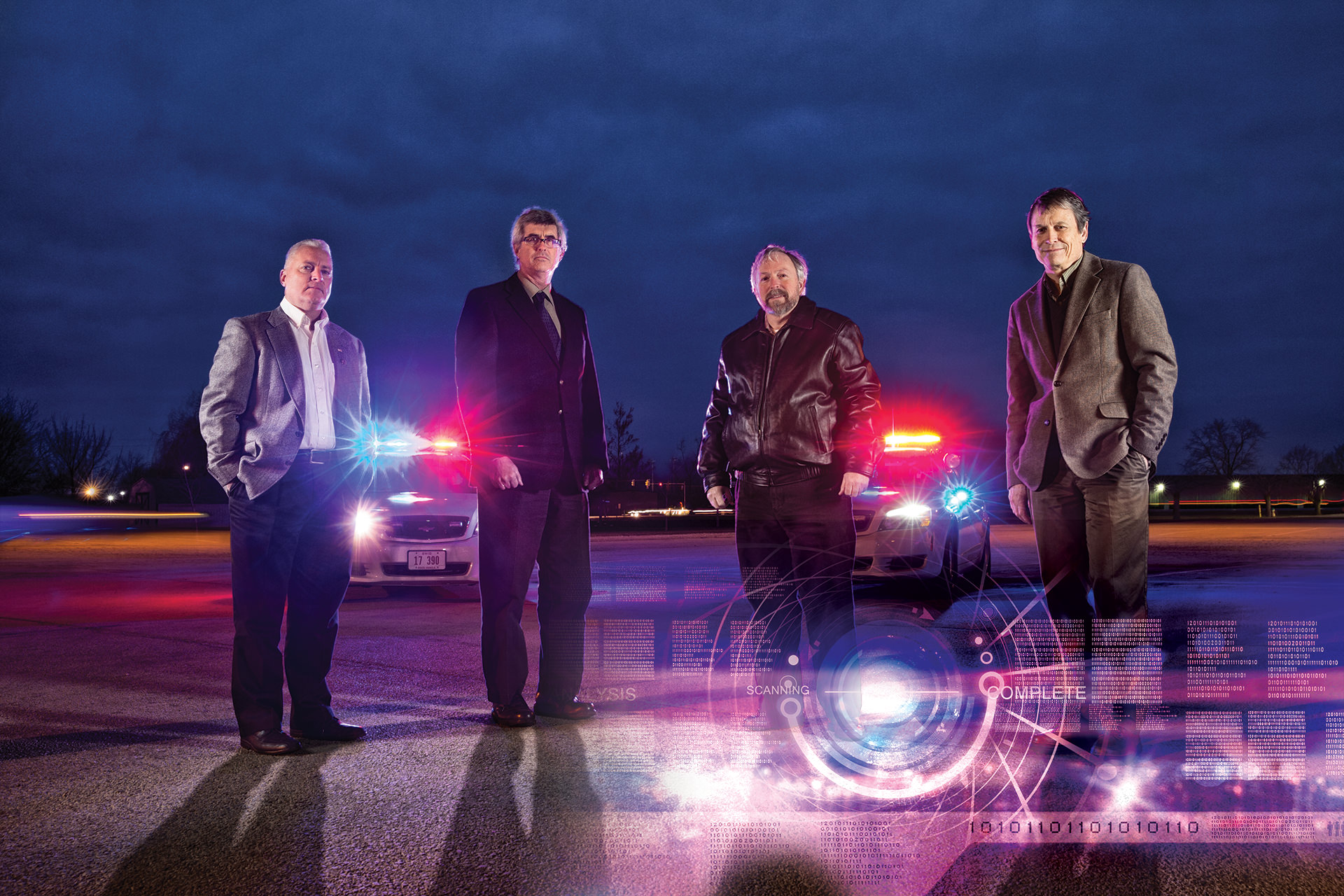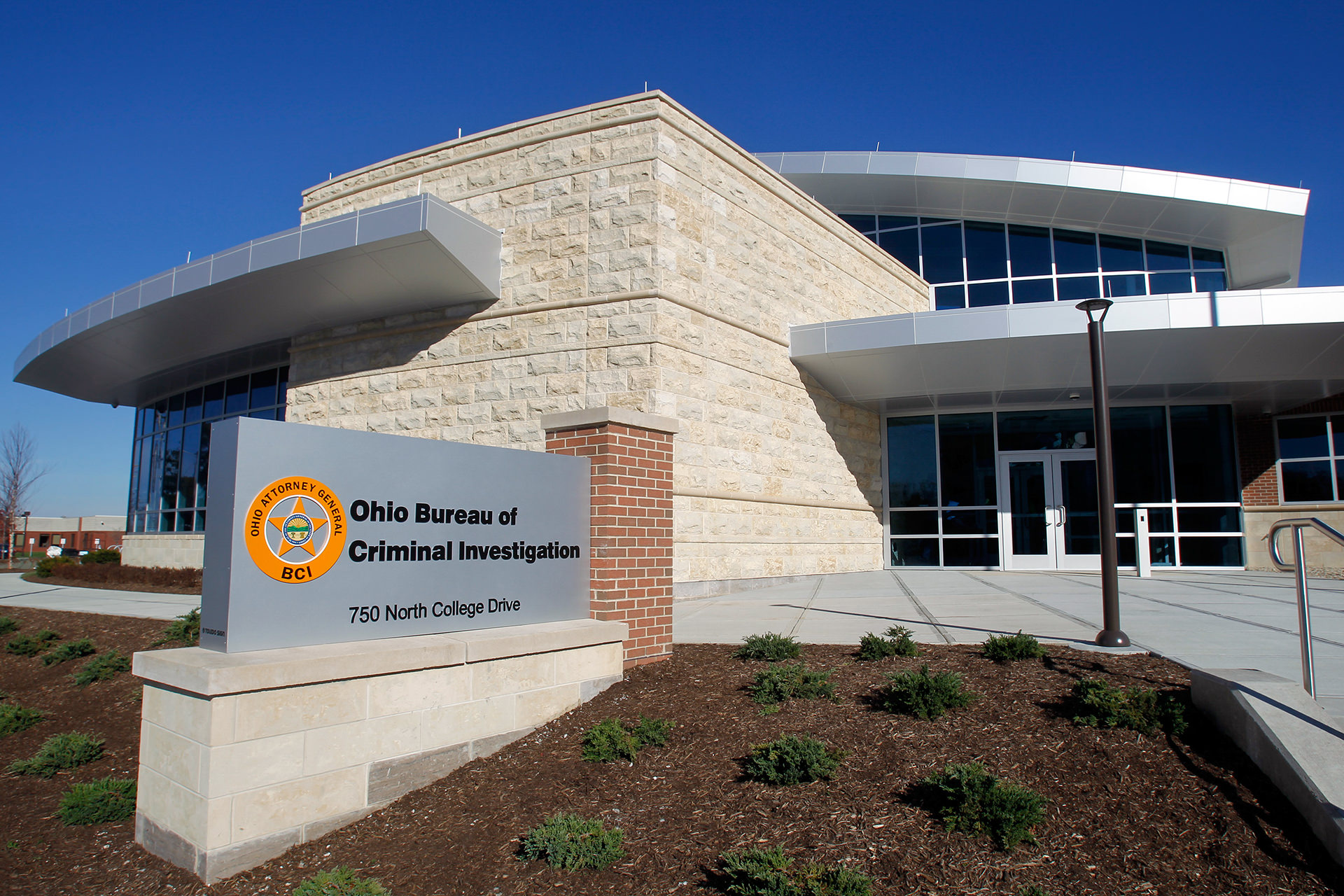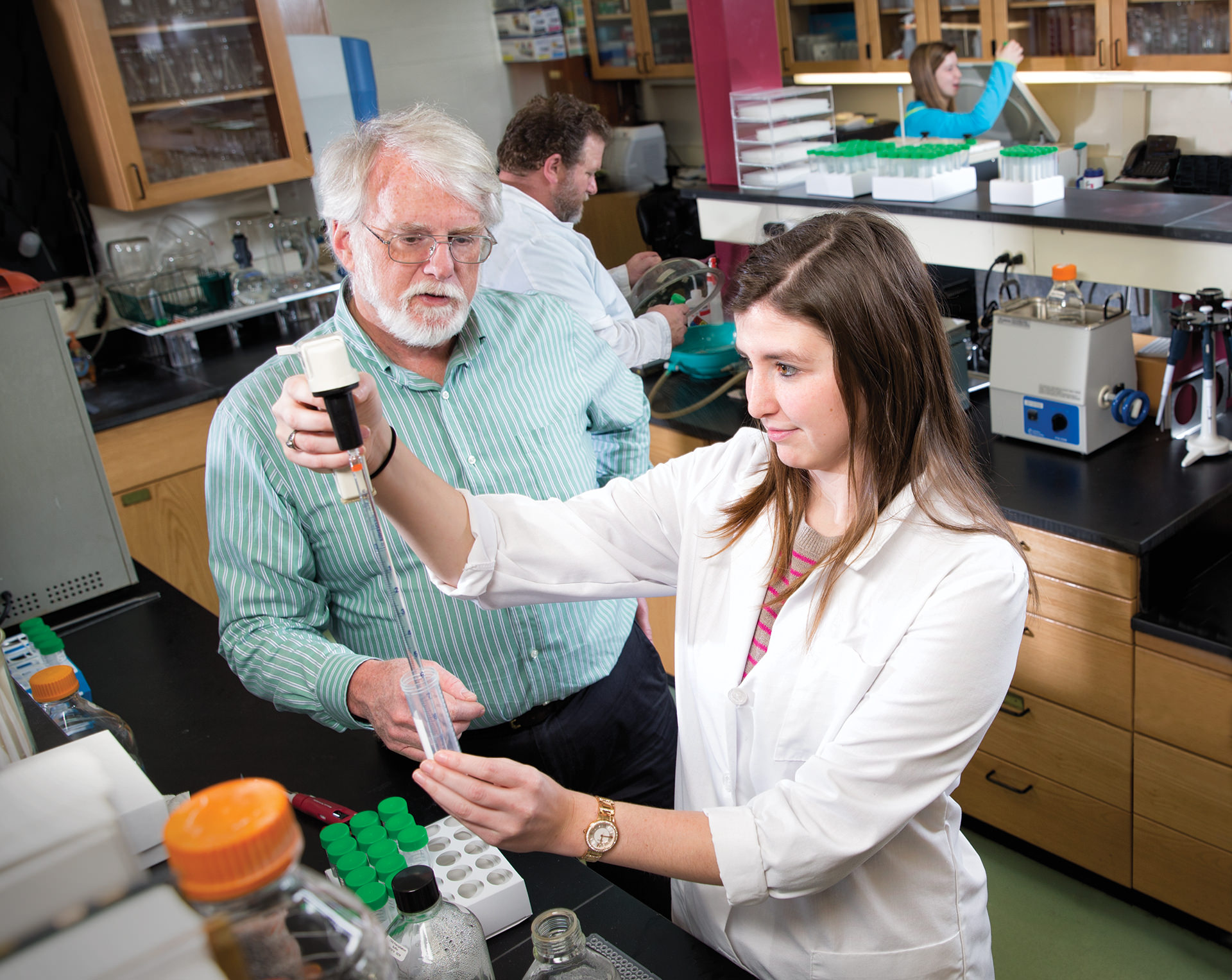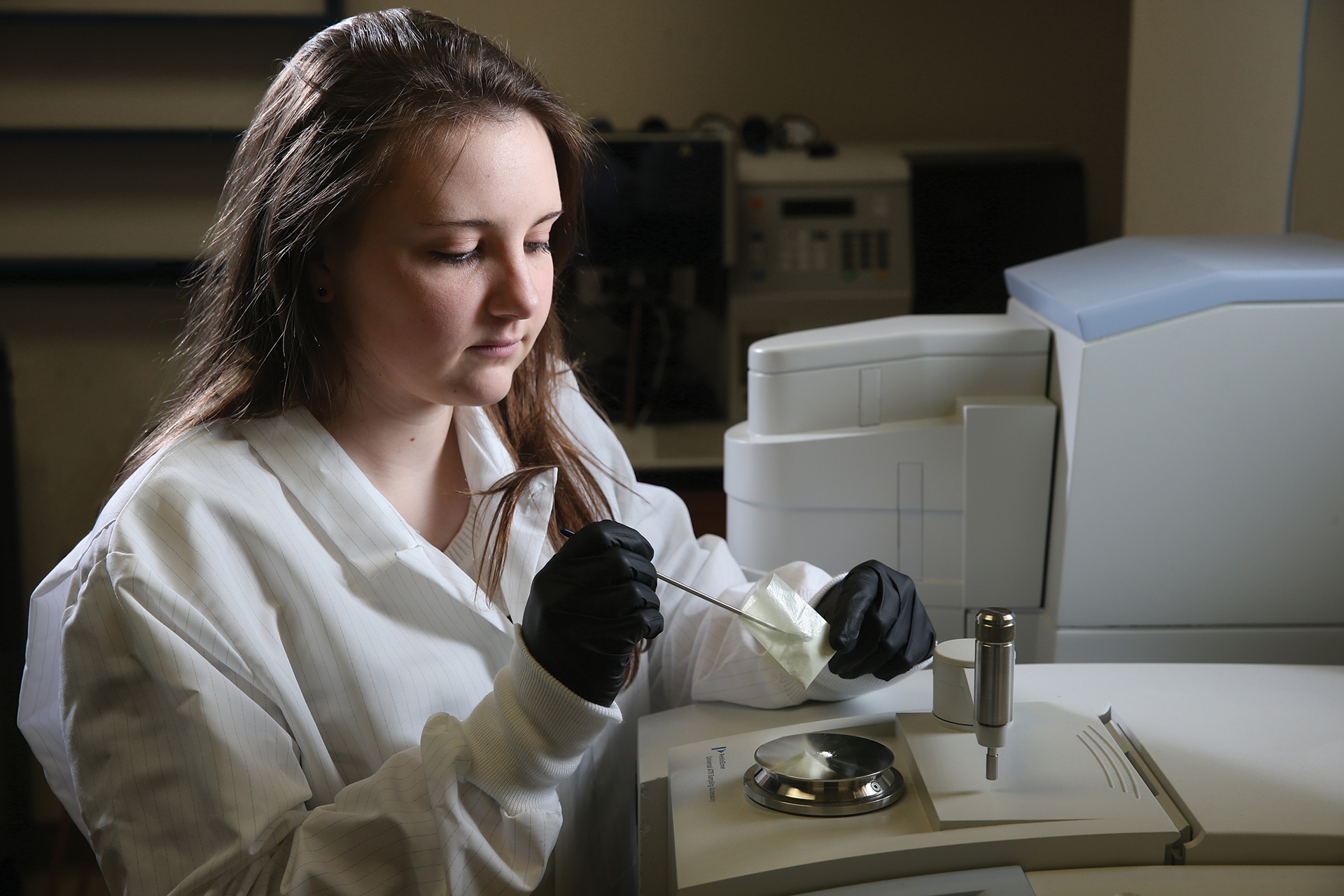
Pictured from left to right: Dr. Jon Sprague, RPh, Ph.D., director of the Ohio Attorney General’s Center for the Future of Forensic Science; Dr. Jeffrey Miner, professor and chair of the Department of Biological Sciences; Dr. Steve Lab, professor and director of the Criminal Justice Program; and Dr. John Cable, professor and chair of the Department of Chemistry

Real Crime Scene Investigators
Story by Bonnie Blankinship
Pictured from left to right: Dr. Jon Sprague, RPh, Ph.D., director of the Ohio Attorney General’s Center for the Future of Forensic Science; Dr. Jeffrey Miner, professor and chair of the Department of Biological Sciences; Dr. Steve Lab, professor and director of the Criminal Justice Program; and Dr. John Cable, professor and chair of the Department of Chemistry
BGSU prepares professionals to solve crime in ways that are more complicated than television shows suggest.
In 2012, a small town in North Dakota received national coverage when two teenage boys died of “designer drug” poisoning within hours of each other. Families were devastated, and law enforcement worked feverishly to identify the substance and track its source before another victim was struck. The drug would eventually be traced to a “hobby chemist” who concocted a lethal variant of Ecstasy.
Today, Bowling Green State University is preparing the professionals who will one day use their expertise to both solve and prevent crimes such as the North Dakota case. The University has added undergraduate specializations in forensic biology, forensic chemistry and forensic criminal investigation, and a master’s degree with a concentration in each is in the planning stage.
Combine all that with BGSU’s innovative collaboration with the new Ohio Bureau of Criminal Investigation (BCI) facility that opened in fall 2014 on the northwest side of campus, and the potential for great things becomes clear.
As the North Dakota scene is repeated across the country, it highlights the challenge for law enforcement and scientists to stay one step ahead of criminals, not only in drug cases, but in all other types of crime as well.
Unlike popular media’s portrayal of the “solitary geniuses” like Sherlock Holmes, when it comes to solving crimes, it really takes more of a village — a village of trained professionals. In the North Dakota drug case, for instance, forensic chemists would analyze the substance to identify it, forensic toxicologists would study its effect on the body, forensic biologists would study DNA left at the crime scene, and forensic investigators would seek the perpetrators.
“Forensics is a process that uses a whole variety of tools to answer questions in criminalistics,” explained Dr. Jeffrey Miner, professor and chair of the Department of Biological Sciences.
Although television crime dramas make it all seem glamorous, a lot of basic, solid work by chemists and biologists often goes into solving crimes, according to Miner and Dr. John Cable, professor and chair of the Department of Chemistry. While they may never actually even meet the investigators who deliver evidence for analysis, thus ensuring objectivity, chemists’ and biologists’ roles are crucial in interpreting evidence.
“It’s a team that works together in a very removed fashion,” said Dr. Steve Lab, a professor and director of the Criminal Justice Program. Working often in parallel, each expert contributes a piece of the eventual case for prosecution, he said.

The new BCI facility houses a veritable village of such professionals, and BGSU students will benefit from access to them through guest speakers who can share the applied version of what students are learning in their classes, classroom presentations and internships, along with donated equipment. The state-of-the-art crime lab will provide investigative and laboratory services for law enforcement in a 22-county region.
In turn, the University assists the bureau. Shortly after the facility opened in November, criminal justice faculty Drs. Philip Stinson and Michael Buerger conducted the first of a series of professional development trainings for the BCI staff, on ethical issues in forensic science.
Other professional development will include training in new Supreme Court rulings, and on preparing and delivering expert testimony. Eventually, BGSU graduate students in forensic sciences will also receive this training, according to Lab.
“Opening this new building with all of its cutting-edge equipment and technology will not only help local law enforcement solve crimes, but also open new possibilities to students who are interested in careers in forensic science and criminal justice,” said Ohio Attorney General Mike DeWine.
When DeWine promoted the new BCI facility being situated on the BGSU campus, he called for it to be as open to the public as much as possible. Lab was among the University personnel who visited other state crime labs in order to have input into the building’s design. As a result, the hallways are lined with windows giving a view into the labs so students and other visitors can observe the methods scientists use to process evidence.
“This allows students to see real investigations taking place without risk of contaminating the evidence,” Lab said.
The University is closely connected with the bureau through Dr. Jon Sprague, director of the Ohio Attorney General’s Center for the Future of Forensic Science, an exceptional partnership between the state and BGSU dedicated to nurturing leaders who will revolutionize the profession of forensic science.
“I see the goal of the center as two-pronged: education and research,” Sprague said. “In fact, we may be unique in the country in being dedicated to those two pursuits. My role is partly that of a facilitator, helping to connect the center educationally to BGSU, helping develop the master’s programs in the forensic sciences, and promoting research in the forensic sciences.”

Dr. Scott Rogers (left) and Alanna Heestand, a junior in forensic biology, measure reagents for work with DNA, which is the focus of laboratory exercises in the Forensic Molecular Biology Techniques lab class.

Dr. Scott Rogers (left) and Alanna Heestand, a junior in forensic biology, measure reagents for work with DNA, which is the focus of laboratory exercises in the Forensic Molecular Biology Techniques lab class.
He will also help arrange training opportunities for state forensic professionals and for students in forensic science-related fields.
“I see the potential here to create and build something unique and innovative,” Sprague said, “for the state and for the nation.”
Sprague has a background that meshes with the interdisciplinary nature of forensics. With a Ph.D. from Purdue University, where he also taught, he is a pharmacologist and toxicologist by training whose research focuses on the neurobiology of addiction and drug toxicities. He has extensive academic as well as administrative experience, most recently as University Director of Academic Research and Head of Pharmaceutical Sciences for the College of Pharmacy at Ferris State University.
Before joining Ferris State, he served as dean and professor of pharmacology at the Raabe College of Pharmacy at Ohio Northern University. That was where he found himself drawn into the study of recreational drugs when, in 2011, previously unknown substances sold as “bath salts” and “spices” hit the streets and people began dying from them. Technically legal, these chemical compounds were variations on the more common but illicit drug Ecstasy. Sprague studied their neurotoxicity and worked with the Ohio Board of Pharmacy and the BCI to help write laws both specific and broad enough to make them illegal.
The State of Ohio’s new Bureau of Criminal Investigation facility provides BGSU with an unparalleled partnership. BGSU faculty provide the bureau with professional development and the bureau provides students and faculty with exposure, training and equipment in the field of forensic sciences.
Now Sprague will work to make the center a resource for the prevention and solving of all types of crime, as summed up in its mission statement: “As the teachers/scholars of forensic science education, we are committed to nurturing leaders in the forensic sciences, developing professionals who contribute to the greater good of society by protecting the public and ensuring justice, advancing the profession and practice of forensic sciences through cutting-edge research.”
Meanwhile, since BGSU began offering the forensic specializations in 2013 following the announcement of the BCI building to be located on campus, “we see a great deal of interest,” Cable said.
“At Preview Days large numbers of people come by our table to talk about it. We’re excited to bring students in; it’s attracting undergraduates.”
Among those students is Katie Quinn, a first-year student from Dayton who had long had an interest in what she described as “the science aspect of criminal justice.” When it came time to choose a college, BGSU, with its new specializations, seemed like the right fit for her.
“I’m drawn to the idea of using science to make sure we have the right person in crime cases and to put criminals behind bars,” Quinn said. “I’ve always enjoyed math and science. In high school, I took part in a career day activity called ‘Murder and Mayhem,’ with a forensic anthropologist and a general forensics professional, and it was really fascinating. I’m looking forward to hearing from the professionals from the BCI and would love to have an internship with them.”

While she is concentrating on her core chemistry curriculum, Quinn is also getting a taste of forensic chemistry this semester in a class for non-majors and is a member of the Chemistry Club.
The forensic specializations in chemistry and biology build on the foundational curriculum in those disciplines and will provide graduates with multiple career options, Miner said. Students with the forensic specializations take the same rigorous sequence of courses as always, but in their second two years will add focused classes in such biology topics as forensic and molecular biology laboratory techniques and molecular DNA analysis, and, in chemistry, analytical and forensic chemistry. Both majors will take a class in law and legal issues in forensic investigation, along with the criminal justice majors.
Most of what students learn in their core courses will translate to the forensic arena. For example, Miner noted that biologists can apply their skills and knowledge in medical entomology to help answer questions in criminal investigations. Identifying insects or soil samples that might be present on evidence or victims can help pinpoint the location of criminal activities, as can analyzing the contents of victims’ stomachs — a technique the biology department already uses to track the movements of fish in its ecological research studies.
The molecular lab classes will be small, and students will work closely with Dr. Scott Rogers, who has experience in the discipline and developed much of the forensics curriculum for biology.
“Science is driven by technique,” Miner said. “You have to be able to do high-end work to get a job in the molecular biology and forensic sciences areas. I think every undergraduate student in molecular biology and forensics, including some graduate students, will want to take this course.”
Senior Christa Wheeler, a forensic biology major from Grafton, Ohio, said she foresees the skills she has gained in her undergraduate research project being directly transferrable to forensic investigation.
“I work in the lab of Dr. Ray Larsen, who studies E. coli,” she explained. “I have my own virus strain. I extract DNA from viruses and compare it with other virus strains. I feel very lucky to have had that experience. My first day on campus, I went to an event for freshmen and transfer students where faculty shared their research work. Afterward, I approached him and by the next day was working in his lab, and I’ve been there ever since.”
Wheeler was a biology major at Lorain County Community College, which has a joint program in biology with BGSU. “My mom is a nurse, and I knew the hospital/doctor’s office setting was not for me,” she said. “I’ve always had an interest in criminal investigation — figuring out how it all happened and bringing the perpetrator to justice. Combine that with biology and you have forensic biology. When I heard BGSU had started a forensics program, I decided to transfer.”
For the chemistry department, the new specialization represents an important new direction.
“Twenty years ago, we as a department created our niche specialization in photochemical sciences,” Cable said. “Now, with the BCI coming to campus, it was a natural for us to add forensic chemistry. We will need to expand our coursework and faculty as the program grows, especially in analytical chemistry. Having Jon Sprague here is a huge step in helping with that.

As a Forensic Chemistry major, Bethany Abbott receives instruction in methods such as mass spectrometry and gas chromatography to be able to identify and analyze minutes parts of a sample.

As a Forensic Chemistry major, Bethany Abbott receives instruction in methods such as mass spectrometry and gas chromatography to be able to identify and analyze minutes parts of a sample.
“I had long thought forensics would be a natural extension of analytical chemistry,” Cable said. “That’s where the overlap lies. Analytical chemists basically ask ‘What is this substance and how much of it is present?’ Linking this with forensic science means applying the standard techniques we use to samples relevant to forensic investigations.”
Looking for the presence of and identifying drugs would be a primary example, he said. Other substances typically might include paint, ink and other compounds.
Analytical chemists utilize such methods as mass spectrometry and gas chromatography, and the chemistry department will train forensics specialist students in applying these to investigations, Cable said.
In designing the forensic chemistry course, he and Dr. Stephania Messersmith, Department of Chemistry, worked with the assistant laboratory director and laboratory supervisor at the BCI lab in Bowling Green.
Already the three departments have received valuable equipment donated when the BCI moved into its new quarters and updated its scientific instruments. A gas chromatograph/mass spectrometer and an infrared microscope will help chemistry students detect and analyze minute parts of a sample, Cable said.
BGSU students are prepared for the cross-disciplinary nature of criminal investigations with coursework in biology, chemistry, criminal justice and forensic sciences.
“This expands our ability to teach undergraduates,” he said. “This is very expensive equipment that would be tough for us to buy.”
The same is true for the biologists, Miner said. “The new equipment will allow us to teach the hands-on molecular laboratory techniques students will need to work in forensic biology.”
As crime show fans know, it’s nearly impossible to conceal the presence of blood and other fluids from investigators. Now BGSU students will learn to use some of the special equipment used by police to detect those substances.
“The BCI has donated black lights and other alternative light sources,” Lab said. “When you spray Luminol® on a crime scene and then shine these lights on it, fluids like blood and semen just light up.”
Criminal justice students in Dr. John Liederbach and Buerger’s classes have already been examining and experimenting with the new equipment, Lab noted.
Senior Matt Dove, a criminal justice major from Columbus, is already planning to return to BGSU for his master’s degree in forensic investigation after graduating this May and gaining some work experience in law enforcement.
“Having a master’s is very helpful in terms of advancement,” he said. “In federal law enforcement, you start two grades higher with a master’s and in some departments it applies in lieu of experience.”
He said having the BCI building on campus will add to an already very hands-on program in criminal justice.
“I’ve wanted to be a policeman since I was a little kid, and I want to eventually be a homicide detective. Our program is so strong because of our amazing professors. They have great experience in the criminal justice field and they bring that into the classroom. Both Dr. Buerger and Dr. Stinson started as policemen, and Dr. Stinson went on to get his law degree. Unlike some other schools’ programs, where you learn ‘about’ criminal justice, here we learn what you’ll actually see, and we get hands-on experience.”
“In Dr. Buerger’s criminal investigations class we learned the steps you’d need to take and what to look for. My courts class with Dr. Stinson was extremely helpful and a part of criminal justice that you don’t always get. We observed real court proceedings. Plus we’re required to do a 480-hour internship that’s double what most programs require.”
Dove’s own internships, with the Toledo parole and corrections systems, gave him a gritty look at the realities of crime and punishment. The internship is so valuable in landing a job, he said, because “it’s not just about having the degree but also about having the experience.”
That experience can be tough, and the curriculum addresses that. In Dove’s chosen specialization of homicides, “Once it’s happened, there’s nothing more you can do, but I want to help people by bringing some peace and some closure to the families. You see a lot of bad things, and part of our curriculum involves learning healthy coping mechanisms so you don’t become that cynical, downbeat person,” Dove said.

Lab is diligent about helping graduates find jobs, Dove said, sharing information about what departments around the country are hiring. And Dr. Melissa Burek, who taught his prisons class and designed the drug policy course, provided strategic guidance to him and another highly motivated student in plotting out their coursework so they could get a head start on their graduate coursework while undergraduates.
The future of forensic science at BGSU holds great potential, and those involved are beginning to envision rich possibilities. “I would like to develop a collaboration for teaching among the other three crime labs in the state, where we could have guest lecturers,” Miner said. “I’d also like to collaborate on research proposals to the National Institutes of Justice, and explore links to current research to see how the tools being used could be used in forensics. I also want to foster the link with our alumni who are working in the field.”
Beyond criminal justice, biology and chemistry, “I can see forensic science eventually weaving through nearly every college in the University,” Sprague said. “Forensic psychology looks at the criminal mind, forensic neurobiology could study criminal behavior; in the business college, there could be forensic accounting, and computer science could include the study of digital evidence such as the trail of emails, logins and Google searches.”
“I think we’re all excited,” Wheeler said. “If anyone is interested in forensics, there are great things happening here right now. I’m kind of sad to be graduating in May because I’d love to stay and see how it all plays out.”
Updated: 12/01/2017 11:59PM

 Read other articles from this issue of BGSU Magazine!
Read other articles from this issue of BGSU Magazine!